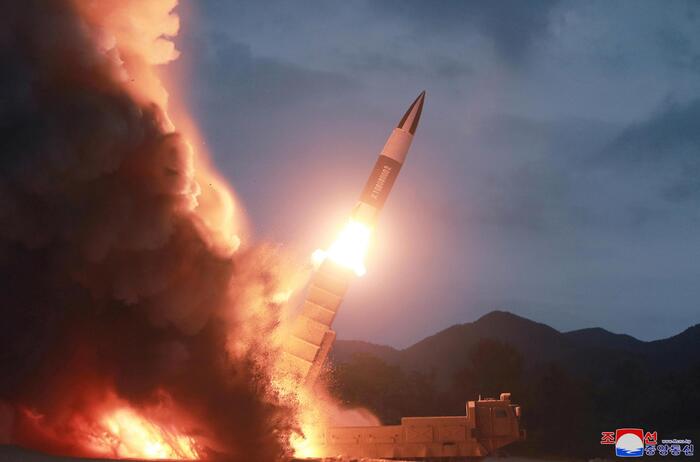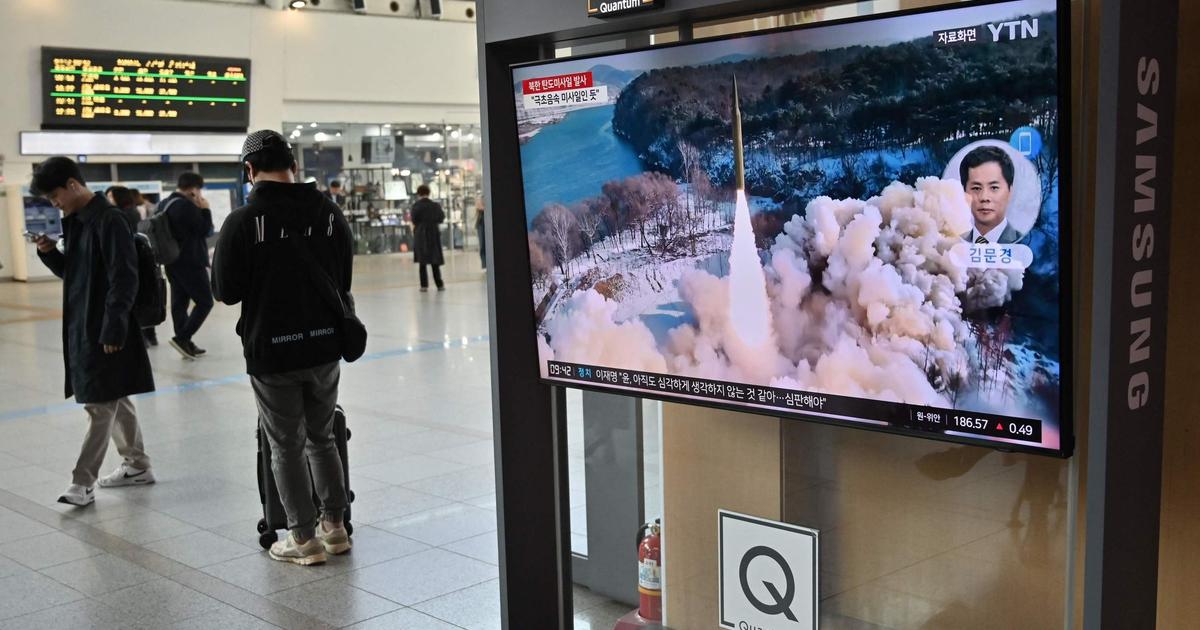Kim Jong Un's 10 years in power 5:05
Hong Kong (CNN) -
North Korea says it tested a hypersonic missile on Wednesday, the second alleged test of such a weapon by the Kim Jong Un regime.
If the claims made in North Korea's state media are true, and at some point the country is able to deploy a hypersonic weapon, it could have profound implications for the security situation in Asia.
But after the first hypersonic test claimed by North Korea in September and the second this week, analysts are cautious.
"A hypersonic missile that can defeat advanced missile defense systems is a game changer if a nuclear warhead is attached to it," said Drew Thompson, former US Department of Defense official and visiting senior researcher at the Lee Kuan Yew School. of Public Policy at the National University of Singapore, after the September test.
But he warned that "that's a big yes. Having it and wanting it are not the same."
And after Wednesday's test, Cheong Seong-chang, director of the Center for North Korean Studies at the Sejong Institute, a South Korean private think tank, said more time and improvements will be needed before Pyongyang can deploy a hypersonic weapon.
This photo that appears to show North Korea testing its latest missile on January 5 was published by North Korea's state newspaper Rodong Sinmun.
"North Korea will need at least two or three more test launches in the future to complete its hypersonic missile," he said.
advertising
What is a hypersonic missile?
When we refer to a hypersonic missile, what we are really talking about is its payload, or what is on top of the rocket.
In this case, the payload is what is called a hypersonic glide vehicle (HGV).
In theory, heavy vehicles can fly up to 20 times the speed of sound and can be highly maneuverable in flight, making them nearly impossible to shoot down, according to experts.
Like ballistic missiles, hypersonic glide weapons are launched by rockets into the atmosphere.
But while a ballistic missile warhead is largely powered by the force of gravity once it begins its descent toward its target from a height of 1,000 kilometers (621 miles), the hypersonics return to Earth before flattening its trajectory from flight, flying only tens of kilometers above the ground, according to a report on hypersonic technology from the Union of Concerned Scientists.
The weapon then uses internal navigation devices to make heading corrections and keep you on target while traveling up to 12 times the speed of sound, according to the report.
Who has hypersonic weapons?
Only two countries, Russia and China, are believed to have deployable hypersonic missiles.
In December 2019, Russia said its hypersonic missile system, known as the Avangard, had entered service.
In a speech to the Russian Parliament in 2018, President Vladimir Putin called the Avangard system "virtually invulnerable" to Western air defenses.
Then in January 2020, Putin oversaw tests of a second hypersonic system, the Kinzhal, off the Crimea.
LEE: Putin assures that Russia is the world leader in hypersonic weapons
And in November, Russia said it successfully tested its Zircon hypersonic missile.
In August, China tested a missile that fell from a heavy vehicle, according to the US military.
First Russian missile launch from a submarine 0:48
"They launched a long-range missile," Gen. John Hyten, then vice chairman of the Joint Chiefs of Staff, told CBS News.
"It went around the world, dropped a hypersonic glide vehicle that glided all the way back to China and hit a target in China."
China denied the allegations, saying what the United States called a hypersonic weapons test was a "routine spacecraft experiment."
At a 2019 military parade, China displayed its DF-17 missile, which it can use to deploy a hypersonic glide vehicle.
A report from the Center for Strategic and International Studies Missile Defense Project, citing US defense officials, says the DF-17 can launch a warhead within meters of its intended target at a range of up to 2,500. kilometers (1,553 miles).
China says it launched a spacecraft and not a missile 0:50
According to a report last year from the Gun Control Association (ACA) in Washington, the United States is working on eight types of hypersonic weapons.
And the military's Defense Advanced Research Projects Agency said it successfully tested a hypersonic weapon last fall.
Can we trust North Korea's claims?
The Kim regime did indeed test a missile on Wednesday and released a picture of the test on Thursday.
Missile experts who have looked at the photo cannot be sure what is shown.
"This missile carries a maneuvering reentry vehicle, or MaRV. The North Koreans advertise it as 'hypersonic,' which is not bad, but to be clear, that doesn't mean it's a novel type of weapon," said Joshua Pollack, Principal Research Associate at the Middlebury Institute for International Studies in California, on social media.
"Whether or not we classify this as an HGV (as noted) or a MaRV is not confirmed," Joseph Dempsey, a research associate for defense and military analysis at the International Institute for Strategic Studies, said in a social media post.
A MaRV is essentially a missile warhead that alters its flight path after re-entering the atmosphere once it has separated from the rocket that launched it.
It's technology that the US military has employed for decades and that South Korea has demonstrated before, according to Pollack.
What distinguishes a MaRV from an HGV is the latter's ability to flatten its flight path and then soar and launch towards a target.
North Korea said Wednesday's test "evaluated the performance of the new lateral movement technique."
"After its launch, the missile made a lateral movement of 120 km in the flight distance of the sliding hypersonic warhead from the initial launch azimuth to the azimuth of the target and accurately hit a target set 700 km away," state media said.
Kim Dong-yub, a professor at the University of North Korean Studies in Seoul, put it simply, saying that North Korea has tested a warhead that can "move up and down multiple times like a descending hang glider. off a mountain "and fly left and right ... for a considerable distance, but still hit the target with precision."
Why the concern?
"North Korea's claims of maneuverability remain significant and could pose additional missile defense challenges," IISS analyst Dempsey said on social media.
Speaking after the North Korean test in September, Roderick Lee, director of research at American Air University's Institute for China Aerospace Studies, said the low-altitude flight paths of hypersonics mean they remain below radars for longer periods, which means less time for missile defense systems to activate and engage them.
"That complicates things a lot for the defender," added Lee.
There is some argument that this makes hypersonics a first strike destabilizing weapon.
"Each side may believe that it has to attack first and fast to achieve its objectives. This dynamic, often referred to as crisis instability, could provoke the start of a conflict even if neither party to the crisis initially planned to attack first." analysts Kelley Sayler and Amy Woolf wrote in a November report for the US Congressional Investigative Service.
What comes next?
North Korea is showing that it will not diminish claims that it is a victim of Western powers and must develop military deterrents for what it sees as possible aggressive moves by enemies like the US and South Korea.
"Rather than expressing its willingness to denuclearization talks or its interest in an end-of-war declaration, North Korea is indicating that neither the omicron variant nor the country's food shortages will stop its aggressive missile development." said Leif-Eric Easley, associate professor of international studies at Ewha Women's University in Seoul.
Cheong, the director of the South Korean think tank, said the fact that leader Kim Jong Un did not directly observe Wednesday's test shows that Pyongyang wants to portray it as part of the normal course of developing military defenses, which it means we can wait more.
"The missile launch was a test conducted in accordance with the five-year defense development plan decided at the 8th Party Congress," said Park Won-gon, professor of North Korean Studies at Ewha Women's University.
"This is North Korea's way of demanding (the international community) to remove double standards on its weapons development and say that these tests are no different from South Korea's missile development."
hypersonic missile







